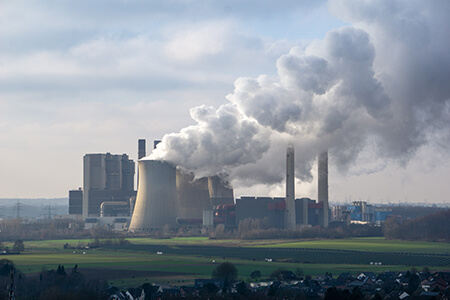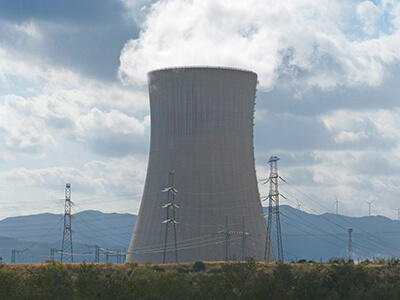This is a lesson summary. The full lesson can be viewed by purchasing an online course subscription.
Learning Objective
In this lesson we will discuss the major types of renewable and non-renewable energy used by humans.
Learning Outcomes
By the end of this lesson you will be able to:
- Distinguish between renewable and non-renewable sources of energy.
- Distinguish between primary and secondary sources of energy.
- Discuss the use of the following renewable and non-renewable energy sources:
- Fossil fuels
- Hydropower
- Wave energy and tidal energy
- Solar energy
- Wind energy
- Geothermal energy
- Biofuels
- Hydrogen
- Nuclear energy
- Discuss the advantages and disadvantages of different sources of energy.

(Image: Martin, Adobe Stock)
Lesson Summary
- Renewable energy is energy derived from renewable resources.
- Non-renewable energy is energy derived from non-renewable resources.
- Primary energy refers to naturally occurring energy sources.
- Secondary energy refers to energy sources that are processed from primary energy sources.
- Fossil fuels are energy-rich substances formed from the remains of ancient plants and animals. They include coal, oil and natural gas.
- Fossil fuels are used for electricity generation and transportation.
- The main advantages of fossil fuels are their abundance and their relatively low cost.
- The main disadvantages of fossil fuels are their environmental and health impacts and their non-renewability.
- Hydroelectric power (hydroelectricity) is the generation of electricity using flowing water as a primary source of energy.
- The main advantages of hydroelectric power are that it is a renewable source of energy and it doesn’t produce greenhouse gases or other pollutants.
- The main disadvantages of hydroelectric power are its environmental impacts, particularly with the construction of dams, and its high set-up costs.
- Wave energy refers to the energy of water waves.
- Tidal energy refers to the energy of moving tidal water.
- Wave energy and tidal energy can be harnessed to generate electricity.
- The main advantages of wave energy and tidal energy are that they are renewable sources of energy and they don’t produce greenhouse gases or other pollutants.
- The main disadvantages of wave energy and tidal energy are their high set-up costs and that they are limited by the amount of moving water.
- Solar energy refers to light energy and thermal energy (heat) produced by the Sun.
- Solar light energy can be converted into electrical energy in photovoltaic cells and solar thermal energy can be used for heating and for generating electricity in solar thermal power plants.
- The main advantages of solar energy are that it is a widely available source of renewable energy and it doesn’t produce greenhouse gases or other pollutants.
- The main disadvantages of solar energy are its high set-up costs and its relatively low efficiency.
- Wind power is the use of wind turbines to convert wind energy into electricity.
- The main advantages of wind energy are that it is a renewable source of energy and it doesn’t produce greenhouse gases or other pollutants.
- The main disadvantages of wind energy are its high set-up costs and that it is limited by the amount of available wind.
- Geothermal energy refers to heat energy radiating from Earth’s core.
- Geothermal energy can be harnessed to generate electricity.
- The main advantages of geothermal energy are that it is a continuous source of renewable energy and it doesn’t produce greenhouse gases or other pollutants.
- The main disadvantages of geothermal energy are that it is limited to specific regions on Earth and it is relatively expensive.
- Biofuel (biomass) is energy derived from dead and decaying organisms and organic waste.
- Biofuels can be used for generating electricity and for transportation.
- The main advantages of biofuels are that they are renewable sources of energy and they can potentially be carbon neutral.
- The main disadvantages of biofuels are that they produce carbon dioxide and other pollutants and that their production requires energy, land and other resources.
- Hydrogen is a gas that can be reacted with oxygen to produce energy – in hydrogen fuel cells and in hydrogen internal combustion engines.
- Hydrogen has applications in electricity generation and transportation.
- The main advantages of hydrogen are that it is an efficient source of energy that produces no carbon dioxide or other pollutants and it can be extracted from renewable sources.
- The main disadvantages of hydrogen are that it is currently mostly produced from non-renewable sources and it is potentially very dangerous as it has a tendency to leak and it ignites easily.
- Nuclear energy is energy stored in radioactive materials.
- Nuclear power is the production of electricity using radioactive materials.
- The main advantages of nuclear energy are its high efficiency and relatively low costs, and that it produces no carbon dioxide or other atmospheric pollutants.
- The main disadvantages of nuclear energy are the production of radioactive wastes and the potential for large-scale nuclear disasters.

(Image: makamuki0, Pixabay)
(Header image: Fokke Baarssen, Adobe Stock)
